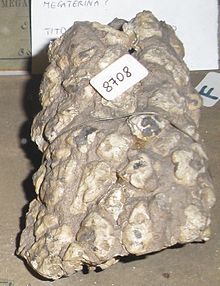- Mylodon
-
Mylodon
Temporal range: Pleistocene to Holocene
Mylodon darwini fur and skin at the Museum für Naturkunde, Berlin Scientific classification Kingdom: Animalia Phylum: Chordata Class: Mammalia Superorder: Xenarthra Order: Pilosa Family: †Mylodontidae Subfamily: †Mylodontinae Genus: †Mylodon
Owen, 1840Species: †M. darwini Mylodon is an extinct genus of giant ground sloth that lived in the Patagonia area of South America until roughly 10,000 years ago.
Mylodon weighed about 200 kilograms (440 lb) and stood up to 3 m (10 ft) tall when raised up on its hind legs. Preserved dung has shown it was a herbivore. It had very thick hide and had osteoderms within its skin for added armor. Because of this armor and its own long and sharp claws, it's unlikely Mylodon had any natural enemies other than humans, who would have still found the skin difficult to pierce with stone projectile points.[citation needed]
Mylodon's close relatives include the giant ground sloths of the genera Glossotherium and Paramylodon. The latter genus has often been confused with Glossotherium but Paramylodon is a distinct genus that was restricted to the Pleistocene of North America.[1] Glossotherium also shares a long history of taxonomic confusion with Mylodon, and currently the only recognized species is Mylodon darwinii. At one time, the elephant-sized Megatherium was thought to be closely related, but is recognized as belonging to a separate family (Megatheriidae).
Contents
Paleobiology
Mylodon has been traditionally considered a grazer in open areas, which is theorized based on its paleoenvironment as well as from the vegetation found in fossilized dung. However, recent studies based on biomechanics and functional morphology indicate that Mylodon may have been a mixed or selective-feeder instead, and the paleoenvironment of the formation where the animal was found indicates a wide variety of vegetation to be selected from.
A variety of specimens found throughout Argentina and Chile indicate that Mylodon had a wide range of climatic and environmental tolerance. It was probably capable of inhabiting arid to semiarid and cold climates, humid and warm climates, and colder and montane climates.[2]
Condition of samples
At several sites preserved hide and dung have been discovered, and are in such a state of conservation that the people who first discovered them believed they belonged to a living animal instead of an extinct species. Mylodon was named by Richard Owen on the basis of a nearly complete lower jaw with teeth, which was found by Charles Darwin in a consolidated gravel cliff at Bahía Blanca, during the survey expedition of HMS Beagle.[3]
Well preserved samples of Mylodon remains have been discovered in the Cueva del Milodón site in Patagonia, Chile along the southern flank of Cerro Benítez in the year 1896. Associated with bones of other early Patagonian animals, these remains of Mylodon date from an era earlier than 10,000 BC.[4]
Survival claims
The discovery of fresh looking samples of skin and dung sparked a small wave of expeditions during the early 20th century to search for a living example of the animal.[5] The samples have since been found to be around 10,000 years old, although they look fresh because of the extreme cold and stable conditions in the caves in which they were found.
References
- ^ McAfee, R.K. (2007). Reassessing the Taxonomy and Affinities of the Myodontinae sloths, Glossotherium and Paramylodon (Mammalia: Xenarthra: Tardigrada). Ph.D. Dissertation, Northern Illinois University.
- ^ Diego Brandoni, Brenda S. Ferrero and Ernesto Brunetto. Mylodon darwini Owen (Xenarthra, Mylodontinae) from the Late Pleistocene of Mesopotamia, Argentina, with Remarks on Individual Variability, Paleobiology, Paleobiogeography, and Paleoenvironment. Journal of Vertebrate Paleontology 30(5):1547-1558. 2010 doi: 10.1080/02724634.2010.501449 September 2010.
- ^ R. Owen (1840). Zoology of the Voyage of the Beagle. Part 1, Fossil Mammalia. Pp. 63-73.
- ^ C. MICHAEL HOGAN (2008) Cueva del Milodon, Megalithic Portal [1]
- ^ "PATAGONIA; Hesketh-Prichard's Stirring Tale of Exploration in the Far South". The New York Times. 20 December 1902. http://query.nytimes.com/gst/abstract.html?res=9503EED71E3DEE32A25753C2A9649D946397D6CF. Retrieved 2008-11-22.
External links
- www.sloth-world.org - Sloth World - an online bibliography
Categories:- Prehistoric sloths
- Pleistocene mammals
- Prehistoric mammals of South America
- Cryptids
Wikimedia Foundation. 2010.

